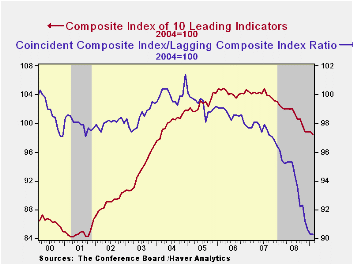 Global| Mar 19 2009
Global| Mar 19 2009U.S. Leading Indicators Fall To Cycle Low
by:Tom Moeller
|in:Economy in Brief
Summary
The Conference Board reported that the February composite index of leading economic indicators fell 0.4% to a new low for this cycle. The decline followed a 0.1% January increase that was downwardly revised. Six of the ten components [...]

The Conference Board reported that the February composite index of leading economic indicators fell 0.4% to a new low for this cycle. The decline followed a 0.1% January increase that was downwardly revised.
Six of the ten components of the leading index rose last month including a sharp steepening of the yield curve, but these gains were offset by materially higher claims for unemployment insurance, shorter hours worked, lower stock prices and reduced consumer expectations.
The breadth of one-month increase amongst the leaders' 10 components improved to 60% but over a six-month period the breadth of gain amongst the components fell to just 20%.
The leading index is based on actual reports for eight economic data series. The Conference Board initially estimates two series, orders for consumer goods and orders for capital goods.
Continuing to reflect economic recession, the coincident indicators dropped a sharp 0.4% and they are off 4.0% during the last year. Half of the four component series fell with outsized declines registered by employment and production. Over the last ten years there has been a 76% correlation between this y/y change and real GDP.
The lagging index fell 0.4% after a 0.3% January decline. The ratio of coincident-to-lagging indicators (a measure of economic excess) was stable at its lowest level since 1975.The Conference Board figures are available in Haver's BCI database. Visit the Conference Board's site for coverage of leading indicator series from around the world.
Risk management in the banking industry is yesterday's U.S. Senate testimony of Roger T. Cole, Director, Division of Banking Supervision and Regulation, U.S. Federal Reserve. It can be found here.
| Business Cycle Indicators (%) | February | January | December | Nov. 6-Month % (AR) | 2008 | 2007 | 2006 |
|---|---|---|---|---|---|---|---|
| Leading | -0.4 | 0.1 | -0.1 | -4.1 | -2.8 | -0.3 | 1.5 |
| Coincident | -0.4 | -0.6 | -0.7 | -6.1 | -0.8 | 1.6 | 2.5 |
| Lagging | -0.4 | -0.3 | -0.1 | 0.9 | 2.9 | 2.8 | 3.3 |
Tom Moeller
AuthorMore in Author Profile »Prior to joining Haver Analytics in 2000, Mr. Moeller worked as the Economist at Chancellor Capital Management from 1985 to 1999. There, he developed comprehensive economic forecasts and interpreted economic data for equity and fixed income portfolio managers. Also at Chancellor, Mr. Moeller worked as an equity analyst and was responsible for researching and rating companies in the economically sensitive automobile and housing industries for investment in Chancellor’s equity portfolio. Prior to joining Chancellor, Mr. Moeller was an Economist at Citibank from 1979 to 1984. He also analyzed pricing behavior in the metals industry for the Council on Wage and Price Stability in Washington, D.C. In 1999, Mr. Moeller received the award for most accurate forecast from the Forecasters' Club of New York. From 1990 to 1992 he was President of the New York Association for Business Economists. Mr. Moeller earned an M.B.A. in Finance from Fordham University, where he graduated in 1987. He holds a Bachelor of Arts in Economics from George Washington University.






